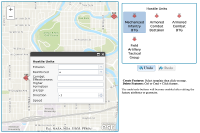 Hide Table of Contents
Hide Table of Contents
 Analysis
Analysis
 Dynamic Layers
Dynamic Layers
 Editing
Editing
 Feature Layers
Feature Layers
 Feature Table
Feature Table
 Graphics
Graphics
 Map
Map
 Mobile
Mobile
 Online and Portal
Online and Portal
 Popups and Info Windows
Popups and Info Windows
 Query and Select
Query and Select
 Renderers, Symbols, Visualization
Renderers, Symbols, Visualization
 Search
Search

Explore in the sandbox
Open in CodePen
View live sample
Description
This sample shows how to use the UndoManager, a utility object, that allows you to incoporate undo/redo functionality into your application. When you create the UndoManager you can specify the number of operations that will be maintained on the undo/redo stack.
undoManager = new UndoManager({maxOperations: 8});
There are several out-of-the-box operations: Add, Delete, Update, Cut and Union. You can also create custom operations by inheriting from the OperationBase class. In this sample we use the Add, Delete and Update operations to maintain a stack of feature edits. This code snippet shows how to add a new operation to the stack. When existing features are updated using the applyEdits method add the update to the stack.
layer.applyEdits(null, [feature], null, function() {var operation = new Update({
featureLayer: layer,
preUpdatedGraphics: [new Graphic(originalFeature)],
postUpdatedGraphics: [feature]
});undoManager.add(operation);
checkUI();
});
});
If the application end-user wants to undo the update they click the undo button which calls the UndoManager's undo method.
Code
<!DOCTYPE html>
<html>
<head>
<meta http-equiv="Content-Type" content="text/html; charset=utf-8">
<meta name="viewport" content="initial-scale=1, maximum-scale=1,user-scalable=no">
<title>UndoManager</title>
<link rel="stylesheet" href="https://js.arcgis.com/3.46/dijit/themes/claro/claro.css">
<link rel="stylesheet" href="https://js.arcgis.com/3.46/esri/css/esri.css">
<style>
html, body {
height: 100%;
width: 100%;
margin: 0;
padding: 0;
overflow:hidden;
}
.instructions{
padding-top:20px;
font-size:12px;
}
.undoButtons{
width:60%;
margin-left:auto;
margin-right:auto;
padding-top:4px;
}
#map{
padding:0px;
border:solid 2px #1A84AD;
border-radius: 4px;
}
#rightPane{
border:none;
width:300px;
}
.templatePicker {
border:solid 2px #1A84AD !important;
}
.undoIcon { background-image:url(images/undo.png); width:16px; height:16px; }
.redoIcon { background-image:url(images/redo.png); width:16px; height:16px;}
</style>
<script src="https://js.arcgis.com/3.46/"></script>
<script>
var map, undoManager, attInspector;
require([
"esri/map",
"esri/layers/FeatureLayer",
"esri/undoManager",
"esri/dijit/AttributeInspector",
"esri/dijit/editing/TemplatePicker",
"esri/dijit/editing/Add",
"esri/dijit/editing/Delete",
"esri/dijit/editing/Update",
"esri/dijit/editing/Editor",
"esri/tasks/query",
"esri/toolbars/draw",
"esri/graphic",
"dojo/parser",
"dojo/_base/event",
"dijit/registry",
"dojo/_base/array",
"dijit/form/Button",
"dijit/layout/BorderContainer",
"dijit/layout/ContentPane",
"dojo/domReady!"
], function(
Map, FeatureLayer, UndoManager, AttributeInspector, TemplatePicker,
Add, Delete, Update, Editor, Query, Draw, Graphic,
parser, event, registry, array
) {
parser.parse();
// specify the number of undo operations allowed using the maxOperations parameter
undoManager = new UndoManager({maxOperations: 8});
// listen for the undo/redo button click events
registry.byId("undo").on("click", function(e) {
undoManager.undo();
});
registry.byId("redo").on("click", function(e) {
undoManager.redo();
});
map = new Map("map", {
basemap: "topo-vector",
center: [-97.367, 37.691],
zoom: 14
});
var landuseLayer = new FeatureLayer("https://sampleserver6.arcgisonline.com/arcgis/rest/services/Military/FeatureServer/6", {
mode: FeatureLayer.MODE_SNAPSHOT,
outFields: ["*"]
});
map.addLayers([landuseLayer]);
map.on("layers-add-result", initEditing);
function initEditing(results) {
var layer = results.layers[0].layer;
var layers = array.map(results.layers, function(result) {
return result.layer;
});
var layerInfos = array.map(results.layers, function(result) {
return {featureLayer: results.layers[0].layer, isEditable: true, showAttachments: false};
});
//Ctrl+click to delete features and add this delete operation to undomanager
layer.on("click", function(evt) {
event.stop(evt);
if (evt.ctrlKey === true || evt.metaKey === true) { //delete feature if ctrl key is depressed
layer.applyEdits(null, null, [evt.graphic], function() {
var operation = new Delete({
featureLayer: layer,
deletedGraphics: [evt.graphic]
});
undoManager.add(operation);
checkUI();
});
}
});
layer.on("before-apply-edits", function() {
dijit.byId("undo").set("disabled", true);
dijit.byId("redo").set("disabled", true);
});
layer.on("edits-complete", function(evt) {
//display attribute inspector for newly created features
if (evt.adds.length > 0) {
var query = new Query();
query.objectIds = [evt.adds[0].objectId];
layer.selectFeatures(query, FeatureLayer.SELECTION_NEW, function(features
) {
if (features.length > 0) {
var screenPoint = map.toScreen(features[0].geometry);
//display the attribute window for newly created features
map.infoWindow.setTitle("");
map.infoWindow.show(screenPoint, map.getInfoWindowAnchor(screenPoint));
}
else {
map.infoWindow.hide();
}
});
}
if (evt.deletes.length > 0) {
//hide the info window if features are deleted.
map.infoWindow.hide();
}
checkUI();
});
//Add the attribute inspector and listen for events to update feature layer
//when attributes are modified.
attInspector = new AttributeInspector({layerInfos: layerInfos}, "attributesDiv");
//display the attribute inspector in the info window.
map.infoWindow.setContent(attInspector.domNode);
map.infoWindow.resize(300, 190);
//delete the feature and close the info window if displayed.
attInspector.on("delete",function(evt){
var feature = evt.feature;
var layer = feature.getLayer();
layer.applyEdits(null, null, [feature], function() {
var operation = new Delete({
featureLayer: layer,
deletedGraphics: [feature]
});
undoManager.add(operation);
checkUI();
});
layer.clearSelection();
map.infoWindow.hide();
});
//show the info window for the next selected feature
attInspector.on("next", function(evt) {
var feature = evt.feature;
var screenPoint = map.toScreen(feature.geometry.getExtent().getCenter());
map.infoWindow.show(screenPoint, map.getInfoWindowAnchor(screenPoint));
});
//Update the feature service attributes and add each attribute change to
//the undo manager for undo/redo capability
attInspector.on("attribute-change", function(evt) {
var feature = evt.feature;
feature.attributes[evt.fieldName] = evt.newFieldValue;
var layer = feature.getLayer();
layer.applyEdits(null, [feature], null, function() {
var operation = new Update({
featureLayer: layer,
preUpdatedGraphics: [new Graphic(originalFeature)],
postUpdatedGraphics: [feature]
});
undoManager.add(operation);
checkUI();
});
});
var templatePicker = new TemplatePicker({
featureLayers: layers,
rows: "auto",
columns: 3,
grouping: true
}, "templatePickerDiv");
templatePicker.startup();
var drawToolbar = new Draw(map);
var selectedTemplate;
//when users select an item from the template picker activate the draw toolbar
//with the geometry type of the selected template item.
templatePicker.on("selection-change", function() {
if (templatePicker.getSelected()) {
selectedTemplate = templatePicker.getSelected();
}
drawToolbar.activate(Draw.POINT);
});
//once the geometry is drawn - call applyEdits to update the feature service with the new geometry
drawToolbar.on("draw-complete", function(evt) {
drawToolbar.deactivate();
var newAttributes = dojo.mixin({}, selectedTemplate.template.prototype.attributes);
var newGraphic = new Graphic(evt.geometry, null, newAttributes);
//when features are added - add them to the undo manager
selectedTemplate.featureLayer.applyEdits([newGraphic], null, null, function() {
var operation = new Add({
featureLayer: selectedTemplate.featureLayer,
addedGraphics: [newGraphic]
});
undoManager.add(operation);
checkUI();
});
});
}
//disable or enable undo/redo buttons depending on current app state
function checkUI() {
if (undoManager.canUndo) {
dijit.byId("undo").set("disabled", false);
}
else {
dijit.byId("undo").set("disabled", true);
}
if (undoManager.canRedo) {
dijit.byId("redo").set("disabled", false);
}
else {
dijit.byId("redo").set("disabled", true);
}
}
});
</script>
</head>
<body class="claro">
<div data-dojo-type="dijit/layout/BorderContainer" data-dojo-props="gutters:true, design:'sidebar'" style="width:100%;height:100%;">
<div id="map" data-dojo-type="dijit/layout/ContentPane" data-dojo-props="region:'center'"></div>
<div id="rightPane" data-dojo-type="dijit/layout/ContentPane" data-dojo-props="region:'right'">
<div id="templatePickerDiv"></div>
<div class="undoButtons">
<button id="undo" data-dojo-type="dijit/form/Button" data-dojo-props="disabled:true, iconClass:'undoIcon'" >Undo</button>
<button id="redo" data-dojo-type="dijit/form/Button" data-dojo-props="disabled:true, iconClass:'redoIcon'" >Redo</button>
</div>
<div class='instructions'>
<ul style="list-style:none;padding-left:4px;">
<li><b>Create Features:</b> Select template then click on map.</li>
<li><b>Delete Features:</b> Ctrl or Cmd + Click feature.</li>
</ul>
The undo/redo buttons will become enabled after editing the feature attributes or geometry.
</div>
</div>
</div>
</body>
</html>